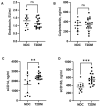Association of Circulating Markers of Microbial Translocation and Hepatic Inflammation with Liver Injury in Patients with Type 2 Diabetes
- PMID: 38927434
- PMCID: PMC11200675
- DOI: 10.3390/biomedicines12061227
Association of Circulating Markers of Microbial Translocation and Hepatic Inflammation with Liver Injury in Patients with Type 2 Diabetes
Abstract
Background: Virtually the entire spectrum of liver disease is observed in association with type 2 diabetes mellitus (T2DM); indeed, T2DM is now the most common cause of liver disease in the U.S. We conducted a pilot study to investigate the relevance of increased microbial translocation and systemic inflammation in the development of liver injury in patients with T2DM.
Methods: Patients with T2DM (n = 17) and non-diabetic controls (NDC; n = 11) aged 25-80 yrs. participated in this study. Serum levels of endotoxin, calprotectin, soluble CD14 and CD163, and several inflammatory cytokines were measured. In addition to standard liver injury markers, ALT and AST, novel serum markers of liver injury, keratin 18 (K-18) M30 (apoptosis-associated caspase-cleaved keratin 18), and M65 (soluble keratin 18) were evaluated. Statistical analyses were performed using the Mann-Whitney test to assess differences between study groups. Pearson's correlation analysis was performed to determine the strength of association between two variables using GraphPad Prism 9.5.0 software.
Results: Patients with T2DM had significantly higher levels of sCD14 in comparison to NDC, suggesting an increase in gut permeability, microbial translocation, and monocyte/macrophage activation. Importantly, relevant to the ensuing inflammatory responses, the increase in sCD14 in patients with T2DM was accompanied by a significant increase in sCD163, a marker of hepatic Kupffer cell activation and inflammation. Further, a positive correlation was observed between sCD163 and endotoxin and sCD14 in T2DM patients but not in NDC. In association with these changes, keratin 18 (K-18)-based serum markers (M65 and M30) that reflect hepatocyte death were significantly higher in the T2DM group indicating ongoing liver injury. Notably, both M65 and M30 levels correlated with sCD14 and sCD163, suggesting that immune cell activation and hepatic inflammation may be linked to the development of liver injury in T2DM.
Conclusions: These findings suggest that the pathogenic changes in the gut-liver axis, marked by increased microbial translocation, may be a major component in the etiology of hepatocyte inflammation and injury in patients with T2DM. However, larger longitudinal studies, including histological evidence, are needed to confirm these observations.
Keywords: T2DM; endotoxemia; liver injury; sCD14; sCD163.
Conflict of interest statement
The authors declare no conflicts of interest.
Figures






Similar articles
-
Diagnostic and prognostic significance of cell death and macrophage activation markers in patients with hepatocellular carcinoma.J Hepatol. 2013 Oct;59(4):769-79. doi: 10.1016/j.jhep.2013.06.008. Epub 2013 Jun 17. J Hepatol. 2013. PMID: 23792028
-
Soluble Markers of Immune Activation Differentially Normalize and Selectively Associate with Improvement in AST, ALT, Albumin, and Transient Elastography During IFN-Free HCV Therapy.Pathog Immun. 2018 Sep 7;3(1):149-163. doi: 10.20411/pai.v3i1.242. Pathog Immun. 2018. PMID: 30370392 Free PMC article.
-
Serum keratin-18 detects hepatic inflammation and predicts progression in compensated alcohol-associated liver disease.Hepatol Commun. 2022 Dec;6(12):3421-3432. doi: 10.1002/hep4.2075. Epub 2022 Oct 20. Hepatol Commun. 2022. PMID: 36264145 Free PMC article.
-
The association of soluble CD163, a novel biomarker of macrophage activation, with type 2 diabetes mellitus and its underlying physiological disorders: A systematic review.Obes Rev. 2021 Sep;22(9):e13257. doi: 10.1111/obr.13257. Epub 2021 Apr 28. Obes Rev. 2021. PMID: 33913230 Review.
-
Cooperation of liver cells in health and disease.Adv Anat Embryol Cell Biol. 2001;161:III-XIII, 1-151. doi: 10.1007/978-3-642-56553-3. Adv Anat Embryol Cell Biol. 2001. PMID: 11729749 Review.
References
-
- Abeysekera K.W.M., Valenti L., Younossi Z., Dillon J.F., Allen A.M., Nourredin M., Rinella M.E., Tacke F., Francque S., Gines P., et al. Implementation of a liver health check in people with type 2 diabetes. Lancet Gastroenterol. Hepatol. 2024;9:83–91. doi: 10.1016/S2468-1253(23)00270-4. - DOI - PubMed
-
- Petit J.M., Hamza S., Rollot F., Sigonney V., Crevisy E., Duvillard L., Raab J.J., Bronowicki J.P., Bernard-Chabert B., Di Martino V., et al. Impact of liver disease severity and etiology on the occurrence of diabetes mellitus in patients with liver cirrhosis. Acta Diabetol. 2014;51:455–460. doi: 10.1007/s00592-013-0538-y. - DOI - PubMed
Grants and funding
LinkOut - more resources
Full Text Sources
Research Materials

